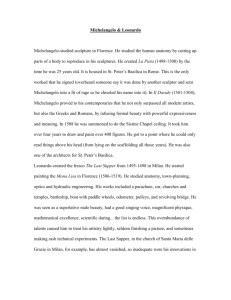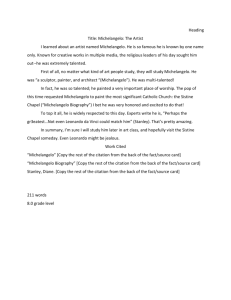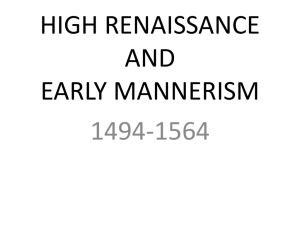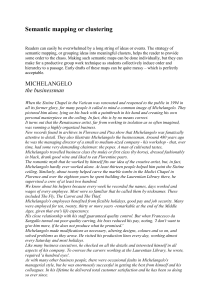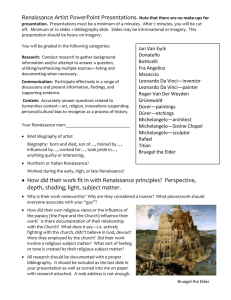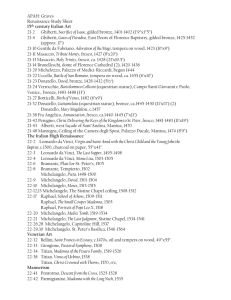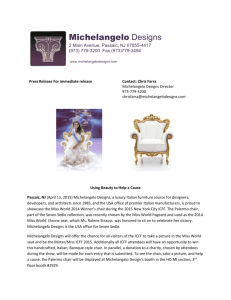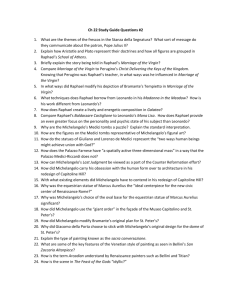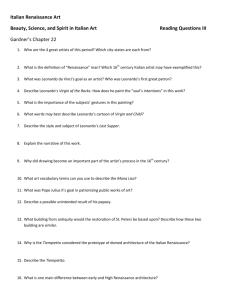Michelangelo and his Father: An Enigmatic Affection
advertisement
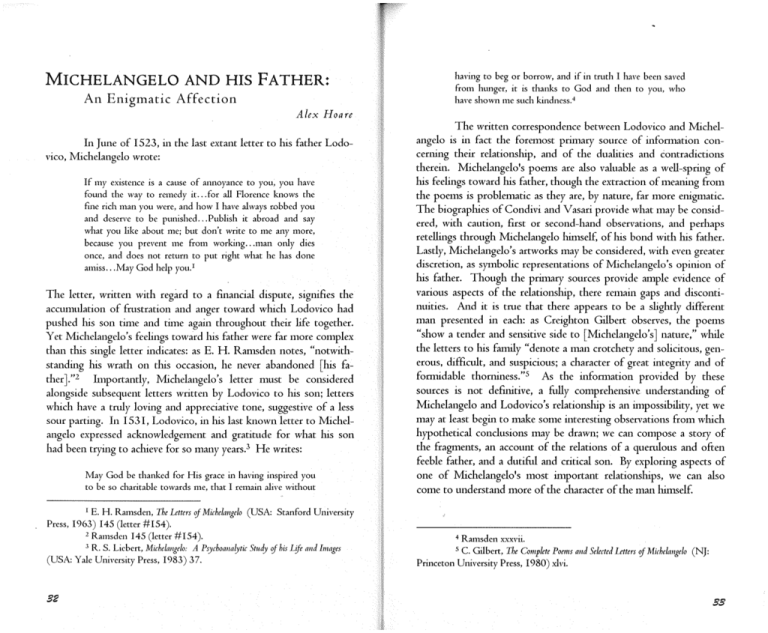
MICHELANGELO AND HIS FATHER: An Enigmatic Affection having to beg or borrow, and if in truth I have been saved from hunger, it is thanks to God and then to you, who have shown me such kindness. 4 Alex Hoare In June of 1523, in the last extant letter to his father Lodovico, Michelangelo wrote: If my existence is a cause of annoyance to you, you have found the way to remedy it ... for all Florence knows the fine rich man you were, and how I have always r.obbed you and deserve to be punished ... Publish it abroad and say what you like about me; but don't write to me any more, because you prevent me from working ... man only dies once, and does not return to put right what he has done amiss ... May God help you.I The letter, written with regard to a financial dispute, signifies the accumulation of fmstration and anger toward which Lodovico had pushed his son time and time again throughout their life together. Yet Michelangelo's feelings toward his father were far more complex than this single letter indicates: as E. H. Ramsden notes, "notwithstanding his wrath on this occasion, he never abandoned [his fatherJ."2 Importantly, Michelangelo's letter must be considered alongside subsequent letters written by Lodovico to his son; letters which have a tmly loving and appreciative tone, suggestive of a less sour parting. In 1531, Lodovico, in his last known letter to Michelangelo expressed acknowledgement and gratitude for what his son had been trying to achieve for so many years. 3 He writes: May God be thanked for His grace in having inspired you to be so charitable towards me, that I remain alive without 1 E. H. Ramsden, The Letters ?f Mic/,elangelo (USA: Stanford University Press, 1963) 145 (letter #154). 2 Ramsden 145 (letter #I 54). 3 R. S. Liebert, Mic/Jelangelo: A Psychoa11alytic Study ?f his Life a11d Images (USA: Yale University Press, I983) 3 7. 32 The written correspondence between Lodovico and Michelangelo is in fact the foremost prin1ary source of information concerning their relationship, and of the dualities and contradictions therein. Michelangelo's poems are also valuable as a well-spring of his feelings toward his father, though the extraction of meaning from the poems is problematic as they are, by nature, far more enigmatic. The biographies of Condivi and V asari provide what may be considered, with caution, first or second-hand observations, and perhaps retellings through Michelangelo hin1self, of his bond with his father. Lastly, Michelangelo's artworks may be considered, with even greater discretion, as symbolic representations of Michelangelo's opinion of his father. Though tl1e primary sources provide ample evidence of various aspects of the relationship, there remain gaps and discontinuities. And it is tme that there appears to be a slightly different man presented in each: as Creighton Gilbert observes, the poems "show a tender and sensitive side to [Michelangelo's] nature," while the letters to his family "denote a man crotchety and solicitous, generous, difficult, and suspicious; a character of great integrity and of forn1idable thorniness." 5 As the information provided by these sources is not definitive, a fully comprehensive understanding of Michelangelo and Lodovico's relationship is an impossibility, yet we may at least begin to make some interesting observations from which hypothetical conclusions may be drawn; we can compose a story of the fragments, an account of the relations of a quemlous and often feeble father, and a dutifi1l and critical son. By exploring aspects of one of Michelangelo's most in1portant relationships, we can also come to understand more of the character of the man himself. 4 Ramsden xxxvii. 5 C. Gilbert, The Complete Poems a11d Selected Letters ?f Michelallgelo (NJ: Princeton University Press, 1980) xlvi. 33 Throughout their time together, Michelangelo and his father endured a complex and unsteady bond. The sources reveal an affectionate and loving son, bound to his father primarJy through feelings of duty. Lodovico is perhaps an equally loving father, but a clumsy and erratic one at that, often, at least from Michelangelo's point of view, driving his son to the brink of madness. And though it is tempting to imagine their affinity in terms of our own modern conception of the father-son relationship, it is important to consider it in the context of the Italian Renaissance. The relationship between father and son was clearly held in high regard in Renaissance Italy; the famJy itself was of central importance, as it is today. 6 Paternal inheritance permeated many aspects of society: the Pope was a powerfUl father-figure, representing the almighty Father himself here on earth; and wealthy Florentine famJies such as the Medici upheld their power with a linear legacy that moved from father to son. Michelangelo intimately experienced each of these paternal frameworks: he was the biological and dutiful son of Lodovico, the adopted son of Lorenzo de' Medici, the d~voted son of Pope Julius II, and the obedient and fearfUl son of God. Alongside this emphasis on the "paternal" was the growing importance in the Renaissance of establishing one's noble ancestry and lineage, an increasing desire to sharpen the historical image of the famJy, with which Michelangelo was hin1self obsessed.? In a poem written sometin1e between I 503 and I 506, Michelangelo made mention of the power of ancestral lineage: "One who lives happJy for many years in one brief hour suffers and laments; another, through famous or ancient lineage shines brightly, and in a moment grows dark." 8 The Renaissance fanlliy was not simply an "association of relations," but a "tradition of prestige and prop- R. A. Goldthwaite, Private Wealth in Reuaissauce Florence: A Study if Four Families (NJ: Princeton University Press, 1968) 252. 7 Goldthwaite 273. 8.J. Saslow, The Poetry if Michelaugelo (New Haven; London: Yale University Press, 1991) 65. 6 34 erty," 9 and establishing a grand lineage was a way to ensure one's own immortality.IO Michelangelo was a proud advocate of such a notion, as was his father, and he created for himself a "famJy romance,"II proclaiming that the Buonarroti descended from the noble Counts of Canossa. It was a fancifUl sentiment which had no factual basis, notwithstanding its reinforcement for Michelangelo by Count Alessandro da Canossa himsel£ 12 The fantastical notion was also emphasized by both V asari and Condivi in their respective biographies. Michelangelo revealed his anxiety over the Buonarroti's ancestry when he concerned himself with the nobJity of the wife his nephew Lionardo was to choose, 13 and, again, when he advised Lionardo on the nall1iug of his chJdren, adhering to what Condivi referred to as the "Florentine tradition" of naming chJdren after fathers or grand-fathers.I 4 Lionardo did in fact name one of his chJdren after his father, Buonarroto, and two after their great-uncle, to the delight of Michelangelo. Interestingly, as R. W. Carden indicates, not much attention has been paid (either by biographers or Michelangelo himself) to the fact that the artist had ancestors of the Rucellai fanlliy: Giovanni Rucellai, the great patron of Alberti who designed for him the Palazzo Rucellai, was apparently third cousin to Michelangelo's grandmother, on his mother's side, Bonda Rucellai.I5 Goldthwaite 273. Goldtl1waite 268. II Liebert 25. 12 J. A. Symonds, The Life if Michelaugelo Buouarroti (Vol. l) (NY: Charles Scribner's Sons, 1925) 2. 13 Ramsden (letter #322). I4 A. Condivi, The Life if Michelaugelo (USA: The Pennsylvania State University Press, 1976) 6. !5 R. W. Carden, Michela11gelo: A Record if His Life as Told i11 His Own Letters mtd Papers (London: Constable and Co., Ltd., 19!3) 8. 9 IO The large extended family was typical of Italy during the Renaissance, 16 and the characterizations of such a family accurately describe those of the Buonarroti. 17 The extended family prospers by "pooling assets, personal connections and information," 18 their financial stability being "secured by a portfolio of diverse investments" of which land was a popular choice and could be, if invested properly, of prin1e value - hence the importance of the purchase of farms, among other investments, for the Buonarroti family. 19 Property and possessions were important to the Renaissance family as a side-product of the obsession with family lineage: a way of "assuring a dynast of his position in history." 20 Indeed;many if not most of Michelangelo's existing letters concern fmancial matters. Extended families, particularly those being now reduced to brothers and their families, shared in their business ventures and had common ownership of property.21 An example is provided by Michelangelo's assistance of his brothers Buonarroto and Giovan Simone in setting up their own business together in 1513.22 . A characteristic of the later Renaissance was that individual members of extended families began investing on their own, for personal gain, the division of fortunes among sons meaning that no one was assured of success.23 The consequence of this fragmentation was that marked differences emerged in the financial status of mem16 D. R. Blisten, The World of the Family: A Comparative Study of Family Orgauizati011 in their Social and Cultural Settings (NY: Random House, 1963) 132- 3. 17 The organization of the extended family is one in which each member "effectively influences decisions concerning the maintenance and activities of their members" (J. Saslow, 133-134); its attitude is one of imm.ortality; its focus is responsibility toward the family; the family is the primary social and economic unit (N.J. Esposito, 106). 18 Blisten 134-5. 19 Goldthwaite 236. 2o Goldthwaite 271. 21 Goldthwaite 252-254. 22 Liebert 51. 23 Goldthwaite 261. 36 hers of a fan1ily, even within the same generation.24 We see this amongst the Buonarroti, perhaps most notably between Michelangelo and his father. This "individualistic" behaviour was exhibited by Michelangelo primarily in the form of an interest in politics, but we can possibly attribute his rebellious pursuit of the fine arts to this trend, as well.2S Michelangelo did make personal investments, such as the first fann he bought in Pazzolatica in around 1506, but it appears that his own investments eventually became shared ones from which the whole family could profit; in I 509 Michelangelo considered letting the house and farn1 in Pazzolatica so his father can retire in cmnfort.26 A small piece of land and three adjoining houses on the Via Ghibellina in Florence were purchased by Michelangelo in March of 1508;27 these too became rewarding family investments. In June of lSI I Michelangelo advised Lodovico to look into buying another farm, similarly intending it to be both an investment and a place for the family to live.28 The purchases of property were occasions for Michelangelo to express his typical caution, worry, suspicion and anxiety when it came to money. He warned his father to be cautious< so they wouldn't be "cheated." 29 Throughout his personal and financial life, Michelangelo craved security, his peace of mind dependent on both property and, as we shall see, patronage.30 Michelangelo was not unique in his financial concerns. He and his family's anxieties may be considered to be a hold-over of the early Renaissance desire to "hide" one's possessions, "for fear of envy, taxation, or danmation." 31 Like many during the Renaissance, Michelangelo was suspicious of the great commercial bankers and Goldthwaite 258. Goldthwaite 259. 26 Ramsden 51 (letter #48). 27 G. Bull, Michelangelo (London: Penguin Books, Ltd., 1995) 83. 28 Ramsden 60 (letter #60). 29 Gilbert xii. 30 Bull 83. 31 E. Welch, Art and Society in Italy: l3 50-1500 (NY: Oxford University Press, 1997) 277. 24 25 37 even wrote to his father to borrow money from elsewhere "so that we may avoid taking money from the bank."32 When it came to matters of finance, Michelangelo was perhaps equally suspicious of his own family. In 1513 he provided Lodovico with power of attorney in order that he could withdraw money from Michelangelo's account, but only under certain conditions as Michelangelo wished to maintain control of his own funds.3 3 The occasion in I 5 II of Lodovico's withdrawal of money from Michelangelo's account at Sta. Maria Nuova, without Michelangelo's permission, likely gave his son further cause for distrust.3 4 · Michelangelo's obsessive concern with money was not out of a ~aterialistic inclination; he consistendy reminded family and friends of his disapproval and rejection of "worldly" possessions and emotions, writing to his father in 1509 that "to lose one's possessions is not to lose one's life." 35 Rather, he lived a relatively ascetic existence. Indeed, Condivi relates that Michelangelo repeatedly told him that he lived like a "poor man." 36 In a letter of 1500, Lodovico expressed concern over Michelangelo's "poor" living conditions and urged him to take better care of himselfP for the sake of his health as much as for the earning of income. It has been suggested that Michelangelo perhaps felt guilty for "surpassing his father and brother in worldly glory," 38 and thus did everything he could for his family and very litde for himself. When a lawsuit was brought against Lodovico by his brother's widow Francesca (in order to regain her dowry after the death of her husband, as was customary in the Renaissance ),3') Michelangelo assured his father that if he were to lose everything, his son would always provide for him.40 Although he was a generous man, Michelangelo had no quahns about continually reminding his family of his self-sacrifice, complaining in the same letter that Lodovico "never recognized or believed" Michelangelo's support.41 Michelangelo's father, Lodovico di Buonarrota Simoni, is most often referred to by biographers in a derogatory fashion, taking a cue from the more negative references in the sources. He is "unsuccessful, gruff," 42 "undistinguished;"43 a "ne'er-do-well;44 " a "born complainer," 45 and "an anxious, touchy man who liked to put on good appearances." 46 Condivi and Vasari, the latter in particular, make Lodovico out to be a better man, perhaps due to the necessity of raising Michelangelo himself to great heights, by association. Condivi's Lodovico is a "good and religious man, rather more oldfashioned than not," 47 and Vasari's is equally admirable in relation to the "most noble and ancient family" of his roots.48 We can never know the true nature of Lodovico's personality, but as we are primarily concerned with him in his relation to Michelangelo, the artist's own letters may be a fairly telling source, albeit a highly subjective one. In the letters, Michelangelo addresses Lodovico as his "most revered" or "dearest" father, and these expressions, though often conceived of as mere conventions of familial politeness, may have been considered more profound by Michelangelo himself. It is worth noting that in the last, angry letter of I523, he refers to his 40 Ramsden 48 (letter #45). Ramsden 75 (letter #82). 42 R. J. Clements, The Poetry '!f Michelaugelo (NY: New York University Press, 1965) 14. 43 Gilbert xxix. 44 Liebert 29. 45 M. Hirst, The Young Michelangelo: The Artist iu Rome (1496-150 1) (London: The National Gallery, 1994) 47. 46 Carden 7. 47 Condivi 6. 48 G. Vasari, The Lives '!f the Artists (1568) (USA: Penguin Books Ltd., 1965) 326. 41 32 R. J. Clements, Renaissauce Letters (NY: New York University Press, 1976) 423. Ramsden (letter #70). Ramsden 60 (letter #59). 35 Ramsden 53 (letter #SO). 36 Condivi I06. 37 Ramsden xxxiv. 38 Liebert 35. 39 A. Moll10, Marriage Allia11ce ill Late Medieval Flormce (Mass.: Harvard University Press, 1994) 16. 33 34 ss father simply as "Lodovico," deliberately omitting an affectionate address. 49 Lodovico was a descendant of an old Florentine family whose economic and social fortunes had greatly deteriorated over the years. 50 His grandfather had been a successful banker, and his father an unsuccessful banker.51 Writes Carden, "The family had been shamed when Lionardo, Michelangelo's grandfather, had failed to find the money for his daughter's dowry in 1449, and resorted to pledging the house he had on the Piazza dei Peruzzi instead." 52 Lodovico seems to have been cursed by the failures of his forebears; his marriage to Francesca in 1472 brought a modest dowry of 416 florins, and in the early years of married life he sometimes had to pawn their belongings to pay his bills and taxes. 53 Carden writes, "The main trouble with Lodovico lay ... in his inability to reconcile himself to the change in the family fortunes that had taken place after the failure of his father's bank many years before, so that he would persist in trying to live like a gentleman 'without a trade,' a role impossible to sustain on the meagre proceeds of his fann lands." 54 Acting as podesta was one of the few "responsible" 'jobs Lodovico held 55 and the great success of his son may have frustrated him. Michelangelo was surely proud of his father's "humble municipal posts" at Chiusi, Caprese, and Castelfranco, and Lodovico provided a model of success to emulate, at least until Michelangelo witnessed his father's lack of ambition first-hand: the yom}-g Michelangelo's connection with the powerful Lorenzo de' Medici would likely have rewarded Lodovico with any number of dignified occupations, but ratl1er than take advantage of the opportunity, he settled for a meagre customs 49 Ramsden 144 (letter #154). 50 J. Saslow, The Poetry of Michelangelo (New Haven; London: Yale University Press, 1991) 8 5 1 Gilbert xlix. 52 Carden 7-8. 53 Carden 8. 54 Ramsden xxxvi. 55 Saslow 8. posttlon. Michelangelo apparently heard Lorenzo's "ironic remark" that Lodovico would "always be poor." 56 Considering the impetuous ambition of Michelangelo, he must have thought something of his father's lack thereof. Michelangelo, the second son of Lodovico and Francesca, was born on March 6th, 1475 in Caprese.57 In a family record book, Lodovico recorded nine godfathers, or compari, present at Michelangelo's christening. This was an unusually large number. Lodovico's choice of the name "Michelangelo" was equally curious: "the prince of archangels who weighs human souls on the Day of Judgment."5 8 George Bull describes the young Michelangelo as "alert, sens1t1ve, intelligent, introspective, and quicktempered ... prone to sickness, but resilient, with black hair and brown eyes flecked with yellow." 59 Condivi and Vasari tell us the tale of Michelangelo being given to a wet-nurse as a baby, a conventional practice of the time, 60 possibly due to his mother's unspecified "illness." He was returned to his family at the age of two or three, 61 and upon his return home, Michelangelo found he had a new brother, Buonarroto, to be followed by two more, Giovan Simone and Sigismondo. Michelangelo's mother Francesca died in 1481, when he was only six years old, and likely had a great impact on his upbringing. His stepmother Lucrezia degli Ubaldini also departed quite early from Michelangelo's life, having married Lodovico in 1485, when Michelangelo was ten, and dying in 1497.62 Psychoanalytic readings have dissected the letters and poems for infonnatimi concerning Michelangelo's loss of maternal care. There is in fact very little within the primary sources directly pertaining to his mother; Michelangelo only mentions her twice, in both cases advis- Clements, The Poetry 291. Saslow 8. 58 Bull 7. 5 9 Bull 9. 60 Liebert I 4. 61 Bull9. 62 Clements, The Poetry 29 I. 56 57 41 ing his nephew Lionardo to name to his daughter after her, on one occasion referring to her as his mother and on the other merely writing her first name. 63 Robert S. Liebert, in his Psyc!Joanalytic Study of Michelangelo proposes that the lack of maternal care he received in his childhood forced Michelangelo to transfer his need for a strong, affectionate mother into the male figures in his life, his father in particul;lr.64 Certainly Lodovico must have taken on a greater signifi-. cance in Michelangelo's life as the sole surviving parent, effectively supplementing both the roles of mother and father and, as a result (and in fairness to Lodovico ), having greater expectations placed upon l)im. While Michelangelo was still young, the Buonarroti family was expanding. Lodovico, as he received only a modest income, 6 > N. Leites, Art a11d Life: Aspects of Micbelallgelo (NY: New York University Press, 1986) 5. 64 Liebert 180. Liebert writes, "Even by the standards of his own time Michelangelo's childhood was traumatic - marked by inconstant care when he was totally dependent, by abrupt losses of the persons responsible for his protection and nurturance, and by little experience with the continuity in attaclm1ents and the dependable and consistent environment that are necessary for the development of stable self and object representations" (Liebert, 16). Michelangelo would later stress these themes of abandonment and deprivation in his letters and poems (and, perhaps, in his art), feeling deserted by those he bad loved and counted upon for reciprocation: his nurse, his mother, his brothers, his father, Lorenzo de' Medici, and Pope Julius II (Liebert, 34). On numerous occasions, Michelangelo spoke of being "turned out" by his father, as in a letter to his nephew Lionardo, written when Michelangelo was sixty-one years old: "You cannot deny you're like your father who turned me out of my own house in Florence" (Liebert, 34). The specific event referred to is not known. Upon achieving his greater successes as an artist, Michelangelo left his father to live permanently in Rome in I 534. It was only three years after the death of his second wife, Lucrezia, and Lodovico was still unemployed, having lost his position at the custom-house when Piero de' Medici fled from Florence (G. Bull, 43 ). 1l1e departure was a "self-exile" (Liebert, 34) characteristic of Michelangelo's famous self-inflicted solitude, which has been suggested to be an imitation of the abandonment he experienced with the death and departure of loved ones (Liebert, 34). 42 soon found himself in very difficult circumstances and was forced to place his sons with the wool and silk guilds. 65 When the young Michelangelo began to exhibit artistic curiosities, his father greatly disapproved; the pursuit of a career as a mere artisan was not considered by Lodovico to be "worthy of their ancient house." 66 Both V asari and Condivi relate the supposed beatings which Michelangelo endured at the hands of his father and other older family members. 67 Michelangelo had been sent to study grammar, as was customary for a young boy with aspiring parents, under Francesco da Urbino. 68 His father also disapproved of Michelangelo wasting his time on literature, considering it to be worse than painting or sculpture.69 Just prior to the Renaissance, a classical education had meant very little to the Florentine upper classes; it was sufficient "to have enough literacy and numeracy to carry on the family business." 70 Lodovico himself "preferred genteel poverty to demeaning labor" and wanted Michelangelo to pursue a more gentlemanly profession. To Lodovico, an artist was merely a craftsman, a man who worked not with his head but with his hands/ 1 But classical education was gradually gaining in importance, and was itself becoming a status symbol, as with ancient lineage, wealth, public office and marriage, of a family's exclusive social position. 72 Lodovico eventually consented to placing Michelangelo as an apprentice in the workshop of Ghirlandaio when he was fourteen years old. 73 Notably, upon establishing himself as an artist, Michelangelo began signing the letters to his father as "Michelangelo, Sculptor." His confidence was no 65 Vasari 326. V asari 326. 67 Vasari 326. 68 V asari 326. 69 Clements, The Poetry 7. 70 R. Porter, M. Teich, The Renaissance i11 Natio11al Co11text (NY: Cambridge University Press, 1992) 32. 71 Gilbert xxix. 72 Porter 32. 73 Vasari 327. 66 43 doubt reinforced by the support of the Medici family, Lorenzo the Magnificent in particular. Lodovico's displeasure with Michelangelo's decision to pursue a career in the arts was soon abated by the acceptance. and encouragement of the great and powerful Lorenzo the Magnificent. It has been suggested that from that point onward, Michelangelo sought and found in his patrons, first in Lorenzo and then in Julius II, surrogate father-figures who encouraged him in his love of art. Though it isn't spoken of in this manner, Michelangelo's apprenticeship to Ghirlandaio was likely his first experience of a male authority figure outside his own home. Mid1elangelo entered an artist's studio, traditionally a family-run business, at the head of which was the father.7 4 Though, as Bull writes, "it seems that Michelangelo retained no very pleasant memory of his sojourn with the Ghirlandaio brothers. Condivi ... hints that Domenico was jealous of him." 75 Lorenzo the Magnificent afforded Michelangelo with the greatest freedom and solace, and made him an honorary member of the Medici household.7 6 Contrary to Michelangelo's natural father, Lorenzo not only accepted Michelangelo's artistic disposition, but promoted and encouraged it. Michelangelo was given his own room in the Medici palace, and "mixed on tenns of guarded familiarity with Lorenzo and his family." 77 But it was Lorenzo with whom he fom1ed a lasting bond: in I 488 Lorenzo lost his wife Clarice Orsini and "drew closer than ever to his children." 78 Condivi and Vasari describe Michelangelo's pride at being singled out for special treatment by Lorenzo.7 9 V asari notes that when Lodovico saw that Michelangelo was enjoy~ng success at the hands of a powerful family, he began to make an effort for the sake of his son: "Michelangelo's 74 M. Wackernagel, The World c!f the Florentine Artist (NJ: Princeton University Press, NJ, 1938) 328. 75 Symonds 13. 76 Gilbert xxx. 77 Bull 17. 78 Bull 17. 79 Saslow 9. father, seeing his son so highly regarded among the great, began to provide him with far fmer clothes than he used to." 80 When Lorenzo died in 1492, Michelangelo returned home to live with his father, mourning deeply the loss of "a great man who had befriended every kind of talent." 81 Lorenzo had effectively supplemented Lodovico's role in Michelangelo's life, and, having witnessed his father's humiliation by Lorenzo on more than one occasion,82 Michelangelo may have come to see Lodovico as ineffectual in comparison to the great Lorenzo. Liebert contends that Michelangelo effectively fostered two kinds of images of the father-figure: "one was an idealized, powerful public figure whom he believed to have an uncommonly strong personal, as well as artistic, investment in him. The other was a weak and denigrated figure - a role fulfilled, in the main, by his real father." 83 Michelangelo sought paternal approval and appreciation from his next great patron, Pope Julius II. As with Lorenzo before him, Julius provided Michelangelo with a strong male authority figure; he was a powerful military leader who had many successes, in contrast to Michelangelo's natural father Lodovico. Like Lorenzo, Julius was a proud patron of the arts, a "father" to the many aspiring artists whom he commissioned.84 Julius and other members of the papal court reciprocated Michelangelo's affection and admiration: after the death of his uncle, Cardinal Leonardo Grosse della Rovere, the nephew of Julius II, wrote to Michelangelo on the subject of the tomb: "We want you to take every care for your safety, because we love you from the heart and want to do everything we can for you."85 Condivi speaks of the mutual affection of Pope Julius and 80 Vasari 332. V asari 332. 82 W ackernagel 290. 83 Wackernagcl 125. 84 Liebert 126. 8S D. S. Chambers, Patrons and Artists in the Italian Rmaissauce (USA: University of South Carolina, 1971) 35. 8! 4S Michelangelo,86 a bond so valued by Michelangelo that he and fel-low devotees like Bramante competed with each other enviously for Julius' approval.87 A poem written by Michelangelo in around ISII is believed to be directed toward Pope Julius himself. Michelangelo was extremely religious, and his desire for a powerful father figure cuh1unated in his relationship with God himself. In a poem written in around 1528, he expressed his vision of God as his creator, as well as the creator of art. 88 Michelangelo was obligated to God as his maker, as he was to his natural father. But God had the ultin1ate power of creation, and he took on a particular importance to Michelangelo as the creator of the arts - the driving force behind his own creative abilities. In the poem, Michelangelo "hails God himself as the master sculptor."89 Michelangelo's revolutionary conception of the Creation of Adam on the Sistine Chapel ceiling is perhaps a visual testimony to his conception of the grand creative abilities of his God. In his old age Michelangelo became increasingly obsessed with the crucifixion, salvation, and a fear for his own "sins."90 Upon the death of his brothers Sigismondo and Giovan Simone, he expressed concern that they had confessed and thereby found salvation.91 Michelangelo's extreme preoccupation with sin may have been somewhat unique: Liebert writes, "Even allowing for the Renaissance convention of overstating one's imperfections and sinfi.tlness, the consistency of this expressed attitude [forces us to look at Michelangelo as an exception]."92 He felt that he, like his father before him, was born into sin,93 expressing this notion in a poem of I532.9 4 In this poem, Michelangelo makes reference to the Cruci86 Condivi 30. Condivi 30. 88 Saslow 128 (poem #46). 89 Clements, Ihe Poetry 66. 90 Clements, The Poetry 222. 9I Clements, The Poetry 123. 92 Liebert 3 I. 93 Clements, The Poetry cif Michela11gelo 223. 94 Saslow 162 (poem #66). ftXion and Christ's suffering, relating himself and his own sin to Christ. By paralleling himself with Christ, as the son of God, he can become closer to the all-powerfi.tl father at a time in his life when he is closer to death himself and in desperate need of salvation.95 Michelangelo's concern with sin may relate to the guilt and obligation he felt toward his father. Christian doctrine required that Michelangelo unconditionally love his father, so his filial duty was inextricably tied to his potential salvation, which was a continual concern. Michelangelo's ideas about love, as with all of his beliefs, are highly complex. On the most basic level, he conceived of two kinds of love, divine and earthly, divine love (the love of God) being the ultimate goal.96 His dual conception of love, together with the dualities of his relationship with his father, echo the division of the era in which Michelangelo found himself: "he was buffeted on one side by the pagan doctrine of the worship of the senses" with the highly cultural and humanistic aura of the Medici household, "and on the other by the dread of an angry God; the harsh piety of Savonarola and religious fervor."97 In June of 1509, Michelangelo wrote, "I have borne every kind of humiliation, suffered every kind of hardship, worn myself to the bone with every kind of labor, risked my life in a thousand dangers, solely to help my family." 98 When his older brother Lionardo left to become a Dominican friar in I 49 I, Michelangelo effectively became the eldest son99 and began to take on the responsibilities which would govern him for the rest of his life. Due to his own great financial success Michelangelo was able to support and provide for his family, becoming the veritable father-figure and provider hinTself. It was not only monetary support that Michelangelo offered; he was forever providing emotional maintenance, advising his 87 Saslow 37 Saslow 29 97 Gilbert xxxi. 98 E. H. Ramsden, The Letters cif Michelallgelo. (USA: Stanford University Press, 1963) 52 (letter #49) 99 Liebert 48. 95 96 47 fanllly on every issue from marriage to social behavior. Upon the death of Michelangelo's favourite brother Buonarroto, Lodovico, in his last extant letter to Michelangelo, expressed gratitude to Michelangelo for everything he had done for his fanllly, and requested that he take care of Buonarroto's children "because they are of our flesh and his."IOO Michelangelo took his nephew Lionardo and niece Francesca under his wing. Motivated not only through a sincere love for the children of his dear brother, Michelangelo likely saw his niece and nephew as invaluable when it came to perpetuating the Buonarroti clan and its honourable ancestry. . At the end of Michelangelo's life he was not only preoccupied with salvation but with the "perpetuation of the Buonarroti bloodline."IOI He became anxious with regard to Lionardo's choice of a bride, and provided the dowry for Francesca's marriage, a duty which would otherwise have been performed by her father. 102 Michelangelo's anxiety over Lionardo's marriage was characteristic of the era; in the Renaissance, "marriage was the most public declaration a family could make of its social position." 103 Lionardo likely became Michelangelo's primary heir, a "surrogate son," 104 as Michelangelo never married or had any children of his own. J. A. Symonds writes, "The strength and the tenacity of [Michelangelo's J domestic affections are very remarkable in a man who seems never to have thought of marrying. Instead of seeking to beget children for his own solace, he devoted himself to the interests of his kinsmen."105 Michelangelo lavished a great deal of attention on the births of Lionardo's own children, in part due to his obsession with the propagation of the Buonarroti clan. 106 To Lionardo, who lost Ramsden xxxvii. Liebert 362. 102 Liebert 52. 103 Porter 32. 104 A. Hayum, 'Michelangelo's Doni T ondo: Holy Family and Holy Family Myth.' in William Wallace, MicheLmgelo's Life and Early Works (NY: Garland Publishing, Inc., 1995) 212. 105 Symonds 9. 106 Liebert 54. his father Buonarroto and then his grandfather Lodovico while still young, Michelangelo "with all his fame and wealth, and his remoteness i11 Rome, unquestionably became an idealized paternal figure."107 Though Michelangelo did all he could for Lionardo, as with the other members of his fanllly, he took almost every occasion to instruct and criticize him 108 in a manner rather reminiscent of Lodovico's own demands of Michelangelo. Michelangelo became the penultimate father-figure, both the disciplinary and the provider. He was getting on in years, and had lost nearly all of his closest friends and confidants. 109 Lionardo, as the focus of his attention and affections, likely had many shoes to fill. Michelangelo's letters reveal that "the increasing economic and emotional dependence of his fanllly on him had the effect of generating mounting contempt for them, along with outbursts of rage."IIO Yet, while he often criticized and castigated his family members for the angst they caused him, he remained consistently protective of them. In 1512, the year of the sack ofPrato, Michelangelo advised his fanllly to leave Florence feeling the city to be unsafe, writing to Lodovico of his concern. 1 II When news reached Michelangelo of his father's illness, he told his brother Buonarroto, "if there were any danger I should want to see him, whatever happened, before he died, if I had to die with him."II2 Michelangelo defended his father repeatedly against those who would harm him; warning his nuisance-of-a-brother Giovan Simone that any mistreatment of their father would result in the removal of his support in helping him and Buonarroto open a shop together.II 3 On another occasion Michelangelo refUsed to help a certain Francesco Consiglio, IOO 101 49 107 Liebert 53. Liebert 53. 109 G. Cambon, Michelangelo's Poetry: Fury if Form (NJ: Princeton University Press, 1985) 20. no Liebert 36. III Ramsden 73-4 (letters #80, #81). Il2 Ramsden 103 (letter #113). 113 Ramsden 52 (letter #49). 108 because his father was unkind to Lodovico.II 4 In a letter of I497 Michelangelo apologized to his father for his occasionally irate remarks, and assured him of his devotion: "Don't be surprised if I have at times written to you so tetchily, for at times I'm very troubled by reason of the many things that befall those who live away from home ... what you ask of me I'll send you, even if I should have to sell myself as a slave."IIS Michelangelo was never married, but in this he was not unusual: Donatello, Botticelli, Leonardo, Raphael, Alberti and many other prominent and successful artists never married. Martin Wackernagel writes, "In connection with the old custom of monastic scholarship, non-monastic sd10lars of the Renaissance also, as a rule, preferred to remain single."II 6 Michelangelo reputedly said that he was instead "married to his art."II 7 Mid1elangelo's statement that he had espoused art itself was not the only one in which he paralleled womankind and the creative act of making art. One may recall Michelangelo's famous conunent that, having been ~eaned by a woman who was both the daughter and wife of stonemasons, he was given as a young child the gifts of a sculptor. There were in fact very few women at all in Michelangelo's life. The only primary female figure was Vittoria Colonna, the marchioness of Pescara, and she appeared quite late in his life, around IS35. Michelangelo befriended her first and foremost on spiritual terms, and regarded her as his religious instructor and mentor;II 8 in his poems he in fact speaks of her in the masculine gender.H 9 Not long after Lodovico's death, Michelangelo met another of his most favoured companions: Tomasso de' Cavalieri, a young Roman nobleman. rzo Liebert suggests that Tomasso presented to Michelangelo a way for him to once Ramsden (letter #68). Ramsden 5 (letter #3). II6 W ackemagcl 353. II? Gilbert xxxi. II8 Gilbert xvii. 119 Gilbert xvii. 12 Condi1·i 144. II4 !IS ° 50 more be the son, "achieving a Ganymede-like immortality in service and devotion to an eternally youthful master."IZI Tomasso would not abandon Michelangelo by dying, which so many of h~s loves had done before. rzz Michelangelo's art may, with caution, be considered an "objectified autobiography." As R. J. Clements notes, Michelangelo "felt the irresistible urge to project himself into his art."I23 Liebert believes that a number of works in particular reflect "the intensity and complexity ... and the different and contradictory aspects of [Michelangelo'sJ relationship with his father:"I 24 two panels from the Sistine Ceiling, The Flood and The Drunketmess if Noah, the Pieta in Florence Cathedral; the drawing of T!Je Children's Bacchanal; and the Doni Tondo, or Holy Family.I2 5 It is doubtfUl, though, that Michelangelo would wholeheartedly agree with this psychoanalytical conjecture, and we can only take Liebert's ideas into consideration with a fair amount of skepticism. Indeed, the verifiable information we can extract from Michelangelo's artworks is even more obscure than that which we can take from the poems. Interestingly though, Michelangelo did himself acknowledge "the crucial role of childhood influences," telling Vasari, however jokingly, that "I sucked in with my mother's milk the chisels and ha111111er with which I make my figures."I26 Further, he would certainly seem to agree that his visual and literary works had an auto-biographical power. In a letter to 121 Liebert ISO. Liebert I 80. 123 Clements, The Poetry 178. 124 Liebert 40. 125 Liebert 3L For example, The Flood, painted between 1508 and 1512, presents two figures which may represent a father carrying his son. Liebert sees in this image evidence of Michelangelo's desire for a strong father figure, and claims that the two figures represent his "yearning for and the cost of consummate union with a powerful father." This is a theme which resurfaces in both his art and letters. In the image of the two figures we see an elderly, powerful father bearing in his arms his fully grown, dead son. "The father clasps his son to his body in a fmal embrace, while averting his gaze." 126 Saslow 8. 122 51 V asari, in which Michelangelo thanked him for the first edition of his Lives, Michelangelo stated that through this great literary work (and by association we may perhaps say atry work of art or literature?), "by rekindling memories of others, long extinguished, you make both them and yourself live for eternity." 127 It is fitting to now consider Michelangelo's longest and most heartfelt poem, exemplary of Clements' claim that Michelangelo's poetry is a kind of "spiritual biography." 128 It is a memoir, Michelangelo's "longest outpouring of grief," 129 written for his father on the occasion of his death. Significantly, Michelangelo had lost his favourite brother Buonarroto just three years earlier in 1528.13° As a final illustration of the mixed emotions Michelangelo felt for his father, the poem reveals a tender "filial piety." He now considers his father to be divine, seeming to forgive and forget the arguments and anin1osity.m In the poem, Michelangelo recalls both his brother and his father, though, as Liebert writes, while he appears to have successfully mourned his brother, recalling him with love, his father has been "permanently internalized ("carved") within him as a tormenting presence." 132 Michelangelo writes: One was a brother to me, and you father of us both; I'm botmd to him by love, to you by duty; I don't know which pain grips or upsets me more. Memory still paints my brother for me, but it sculpts you within my heart as if alive, which afflicts my heart and stains my face even more.B 3 Liebert claims that this distinction indicates that Michelangelo felt bound to his father solely by duty or an "obligatory tie" 127 Saslow 33. Clements, The Poetry 2. 12 9 Clements, The Poetry 29 I. Bo Clements, The Poetry 292. BI Clements, The Poetry I 83. 132 Liebert 38. !33 Saslow 205 (poem #86 ). !28 52 rather than affection.B 4 But tl1e notion of love as being "greater" than duty (which seems to be Liebert's motivation in drawing attention to it) is immediately dispelled by Michelangelo in the next line; he is equally distraught by the loss of both, in a way effectively equating love and duty. His memory "sculpts" Lodovico "within" his heart, and "afflicts" his heart even more so than the memory of his brother; these are more the words of a pain inflicted by love, and hardly those of a man who considers "duty" to be a loveless emotion. Michelangelo reveals a simultaneous resentment and envy 13 5 of his father's death when he writes: Now that heaven has taken you from our misery, have pity on me, who am living as if dead here where it willed me to be born through you. Now you are dead to death and made divine, and no longer fear a change of life or desire, which I can scarcely write without envy. .. .In your death I am learning how to die.l 36 He repeatedly states his desire to rejoin his father in heaven, revealing that the death of family and friends does not discourage his faith but further confirms it.I 37 He sees God "revealed" in the eyes of the dead and wants it for himselfP 8 Michelangelo's father has shown him that it is wrong to fear death; Lodovico's death, as he himself affirms, has taught him how to die.B 9 Michelangelo was never very clear about his belief in the afterlife; for Michelangelo, "the fantasy of union in death between father and son [alsoJ carried with it the dread of bodily disintegration." 140 Thus, death still carries an element of darkness for Michelangelo, and Liebert relates 134 Liebert 38. Liebert 39. B 6 Saslow 206 (poem #86 ). 137 Clements, The Poetry 29 I. 138 Clements, The Poetry 4 7. 13 9 Clements, IIJe Poetry 292. 140 Liebert 40. 135 53 aspects of the poem to two myths: firstly, the Ganymede myth in which Michelangelo is "driven by the need to restore his father as a vital inner presence", and secondly, the Laocoon myth, in which Michelangelo is "helplessly bound to his father in a frightening death." 141 The poem is unfinished, and Liebert considers that it was abandoned, "like so many of his sculptures," as a reflection of the anger Michelangelo felt at being deserted, in death, by his father.I 42 This notion, as with much of the conjecture regarding the circumstances of Michelangelo and Lodovico's relationship, is questionable. In order to attain a fUll understanding of the relationship Lodovico's point of view rec1uires consideration. Unfortunately, primary sources regarding Lodovico are sparse; his letters are really the only valuable documentation available. As with the majority of Michelangelo's letters, his father's primarily concern "minor business and financial matters and everyday affairs,'' 143 interspersed with an occasional indication of Lodovico's personality. His letters reveal irritation, demands, and "kindly parental concer~1." 144 The overwhelming conclusion that many have drawn is that Michelangelo held no great affection for his father.I 45 Liebert proposes that Michelangelo "rationalized" his otherwise "unbreakable and ambivalent tic" to his father as "self-less ft.lial duty." 146 And the very ways in which his early biographers envelop the relationship in a negative aura force one to consider th.at it was primarily thus. But this view is a cold one, and makes no allowances for Michelangelo's (albeit occasional) declaration of love for his father, the prime example being the 2.3-stanza poem recounted above. As previously stated, the sources are far from concise, and as with any exploration of a 500 year-old relationship, it is iinpossible to create a complete pic- ture. Michelangelo's angry letter of 152.3 is in many ways an extreme contrast to the loving poem written for Lodovico at the time of his .death; it reveals that "in the final balance he felt admiration as well as deep filial affection." 147 The two documents, together, reveal the complex dual nature of the relationship between Michelangelo and his father; a bond which clearly meant more to Michelangelo than a simply ambivalent or dutifUl obligation. Michelangelo perhaps saw within Lodovico two personalities: an admirable and deserving father, and a weak and pitiable man. Similarly, Lodovico possibly created two personas of Michelangelo: a doting and dutifUl son and a demanding and deft.ant boy. The dualities they created for themselves and for each other could never be reconciled; for Michelangelo, perhaps not even in death. He wrote in the last letter to his father, "Take care of yourself and beware of those whom you must beware. For man only dies once, and does not return to put right what he has done amiss." 148 And yet, in a moment of grief and remorse, Michelangelo characteristically contradicts the angry statement of this letter, filling the eulogistic poem with a sentiment of forgiveness: But who is there who would not weep for his dear, dead father. .. ? Death is not .... the worst for one, who, through grace, rises up on his final day to his first eternal one near the divine throne, where, God willing, I presume and believe you are, and where I hope to see you. 149 Clements, The Poetry 292. Ramsden 145 (letter #I 54). 14 9 Saslow 206 (poem #86). 147 141 Liebert I 79. Liebert 39. 143 Liebert 36. 144 Liebert 37. 145 Clements, The Poetry 292. 146 Liebert 174. 14 2 54 148 55
